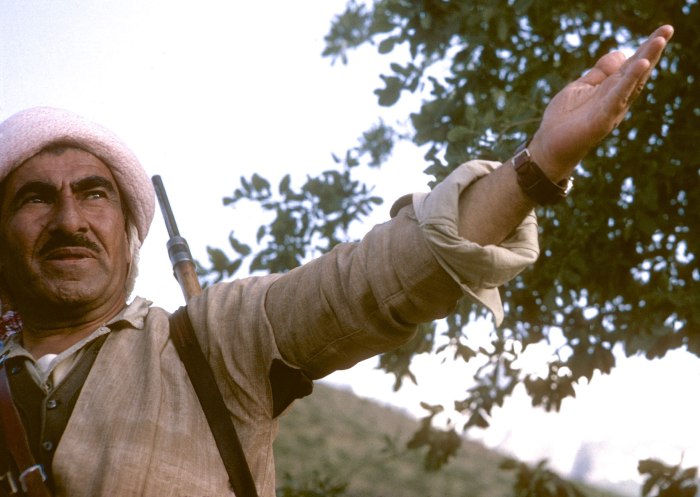Posts Tagged ‘Kurdistan’
Much More on the Kurds Part 6
northern Iraq 1965
photographs and text © William Carter
They defended their birthright as a people.
Copyright statement: William Carter papers, © Stanford University Libraries. Click here for a detailed usage guide.
Much More on the Kurds Part 5
northern Iraq 1965
photographs and text © William Carter
Copyright statement: William Carter papers, © Stanford University Libraries. Click here for a detailed usage guide.
Much More on the Kurds Part 4
northern Iraq 1965
photographs and text © William Carter

Mullah Mustafa Barzani (right) with an assistant

Marching peshmergas getting directions from locals

Shepherds in spring: Kurds and their lands are distinct from others in the Middle East

Migrant shepherd family in spring

Relaxing in a village tea shop

Christian girl sheltering in a cave from Iraqi bombing

Mullah Mustafa Barzani during our last interview
Copyright statement: William Carter papers, © Stanford University Libraries. Click here for a detailed usage guide.
Much More on the Kurds Part 3
northern Iraq 1965
photographs and text © William Carter

This Carter photograph was taken in Yemen, prior to William Carter’s visit to Kurdistan. Newly arrived Carter had been traveling in Yemen with veteran New York Times correspondent Dana Adams Schmidt, who told Carter about then little-known Kurdistan and who later helped him get there.

Kurdish villagers beside a well-used road in northern Iraq

Kurdish village, northern Iraq

Spring religious ritual, near the Iraq-Iran border

Spring religious ritual, near the Iran-Iraq border
Copyright statement: William Carter papers, © Stanford University Libraries. Click here for a detailed usage guide.
Much More on the Kurds Part 2
northern Iraq 1965
photographs and text © William Carter
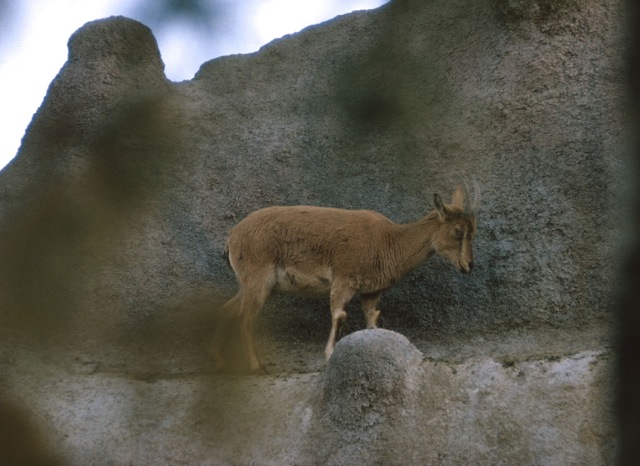
Native Ibex from Kurdish area of eastern Iraq or western Iran
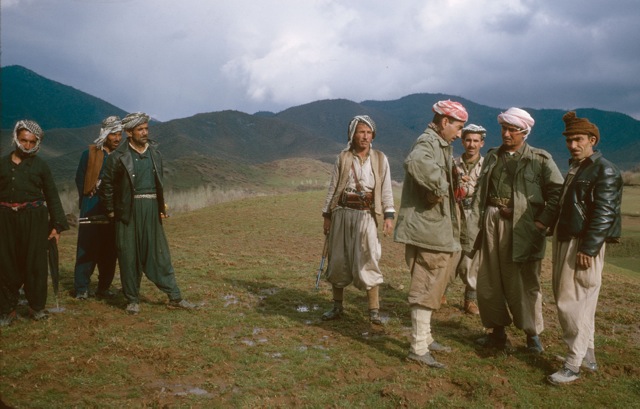
Conference between locals and peshmerga commanders

Burial of an executed “josh” (“donkey” or Iraqi government spy)
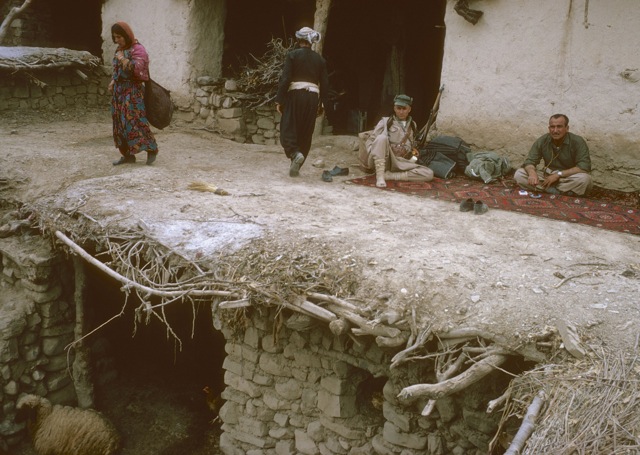
Peshmergas enjoying home hospitality in village north of Suleimaniya
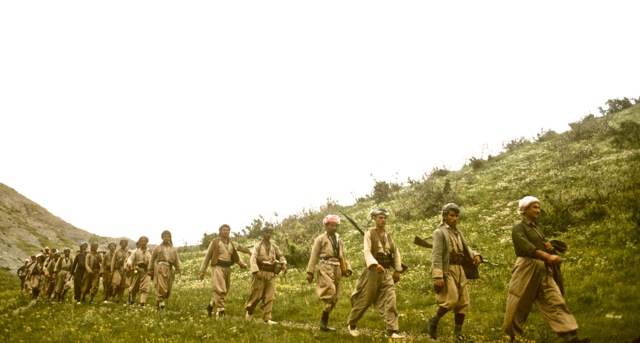 Peshmerga platoon on the march
Peshmerga platoon on the march
Copyright statement: William Carter papers, © Stanford University Libraries. Click here for a detailed usage guide.
Seeds of Today’s Headlines
plus some heartwarming responses
by William Carter
Running in this space for several months, my Kurdish blogs attracted wide attention, not least from the Kurds themselves. Seeing unknown, 50-year-old photographs of their own legendary founding hero, Mullah Mustafa Barzani (left), was a heart-warming revelation.
One non-Kurd who responded was Chris Kutschera, who runs a photo archive in Paris dedicated to his and others’ photographs from Kurdistan, and to his several books and many articles on the Kurds. Chris has added a number of my 1965 photographs to his ongoing collection, which can be visited at www.chris-kutschera.com
These days I get up early to scour the headlines for the latest news of the Kurdish peshmergas’ valiant struggle against the ISIS marauders in Syria and Iraq, helped by U.S. airdrops of supplies. Those of you who see the New Yorker magazine can read Dexter Filkins’ recent report in depth and detail on these special people.
Over the years visiting journalists, including myself, have admired these proud and independent folks to the point of struggling to maintain professional objectivity on the ins and outs of their long-running struggle for “autonomy” within existing Iraq, Turkey, and Syria — or, one day perhaps, independence as a separate nation.
One Kurd who responded to my photographs of the ancient Mesopotamian stones was Kozad Ahmed. A Kurdish archeologist born in Baghdad in 1967 (two years after my visit), he contextualized those stones in his detailed 2012 Ph.D. thesis at the University of Leiden in Holland, titled “The Beginnings of Ancient Kurdistan” (c. 2500-1500): A Historical and Cultural Synthesis.” Evidently those stones were smuggled out of the village of Betwata the 1970s, auctioned in Geneva and are now in museums in Jerusalem and Baghdad.
Copyright statement: William Carter papers, © Stanford University Libraries. Click here for a detailed usage guide.
Iraqi Kurdistan: More Surprises (Part 3)
Many of us learned in school that Mesopotamia’s Tigris-Euphrates Valley cradled the world’s earliest civilization. Unending waves of conquest would sweep over this well-watered land, obliterating much — but not all — of its history. Recent violence in northern Iraq spotlights once-isolated ethnic groups, such as the Yazidis and the Chaldean Christians; Aramaic-speaking villagers as well as remote members of the Muslim Kadri sect. Some of these far-flung peoples and languages date back thousands of years.
And, archeologists have long suspected there were important artifacts from ancient Mesopotamia still awaiting discovery in caves in Kurdistan. I learned this after a journalistic trek on foot and by donkey through the mountains of Iraqi Kurdistan “recently” — only fifty years ago.
Welcomed by the, as yet, little-known Kurdish peshmerga guerrilla fighters, I was doing a photo story on their long-running struggle for autonomy within Iraq and Turkey. At one point my hosts showed me broken, thick stone rock carvings a local sheik had had dragged out of a cave. Evidently he wanted to sell them to me, but I was not in that business. It would have taken an expedition to move them. I took pictures of them, with their hieroglyphic writing. The next year, in London, I showed the photographs to the British Museum. The experts became quite interested, and wanted lots of details, including the exact location, which I was unable to provide other than “oh, we just happen to stop there for tea last June on the march from point A to point B, somewhere north of Sulaimaniya.” Nonetheless the British Museum reproduced my pictures in a scholarly publication.
Given the destruction of the once wonderful Baghdad Museum occasioned by the Bush-era invasion, I sometimes wonder if that stele, and others (?) like it, are not safer staying in their caves. During Saddam Hussein’s ruthless bombings and gassings of isolated ethnic villages — as under the current Isis marauders — some of these thousand-year survivors have themselves reverted to living in caves. Again, I photographed one group all too briefly before hurrying on to rejoin the peshmergas’ march. I always wanted to go back and explore these other ethnicities of Kurdistan, but that was not to be. This year, 2014, the Kurds invited me to fly into Erbil, now a modern city built on oil revenues. We would have loved to, but pushing 80, I hesitated — luckily, just before a new wave of gunmen surrounded the city.
Iraqi Kurdistan 1965 photographs © William Carter
Copyright statement: William Carter papers, © Stanford University Libraries. Click here for a detailed usage guide.
Iraqi Kurdistan: More Surprises (Part 2)
In this part we focus, in black and white, on the villagers and shepherds living in the mountains of northern Iraq in 1965.
For background text, please see the previous blog (part 1).
Iraqi Kurdistan 1965 photographs © William Carter
Copyright statement: William Carter papers, © Stanford University Libraries. Click here for a detailed usage guide.


















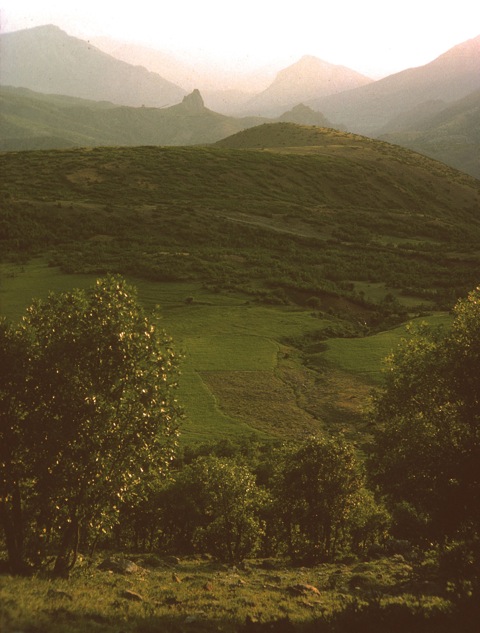
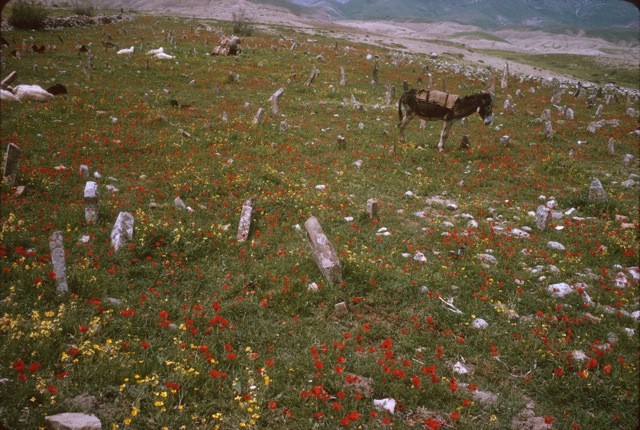


















































![[kneeling in a line] With Kurdish pesh mergas, Iraq, 1965 [kneeling in a line] With Kurdish pesh mergas, Iraq, 1965](https://i0.wp.com/bywilliamcarter.wordpress.com/wp-content/uploads/2012/03/kurdsi002.jpg?w=232&h=150&ssl=1)








































